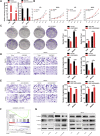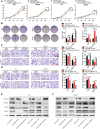p53-Induced LINC00893 Regulates RBFOX2 Stability to Suppress Gastric Cancer Progression
- PMID: 35127712
- PMCID: PMC8807521
- DOI: 10.3389/fcell.2021.796451
p53-Induced LINC00893 Regulates RBFOX2 Stability to Suppress Gastric Cancer Progression
Abstract
Long noncoding RNAs (lncRNAs) have been reported to regulate diverse tumorigenic processes. However, little is known about long intergenic non-protein coding RNA 00893 (LINC00893) and its role in gastric cancer (GC). Herein we investigated its biological functions and molecular mechanism in GC. LINC00893 was decreased in GC tissues but significantly elevated in AGS cells after treatment with Nutlin-3. In GC patients, it was found that low expression of LINC00893 was correlated with tumor growth, metastasis and poor survival. Functionally, overexpression of LINC00893 suppressed the proliferation, migration and invasion of GC cells. Mechanistically, LINC00893 regulated the expression of epithelial-mesenchymal transition (EMT)-related proteins by binding to RNA binding fox-1 homolog 2 (RBFOX2) and promoting its ubiquitin-mediated degradation, thus suppressing the EMT and related functions of GC. In addition, the transcription factor p53 can regulate the expression of LINC00893 in an indirect way. Taken together, these results suggested that LINC00893 regulated by p53 repressed GC proliferation, migration and invasion by functioning as a binding site for RBFOX2 to regulate its stability and the expression of EMT-related proteins. LINC00893 acts as a tumor-inhibiting lncRNA that is induced by p53 in GC and regulates EMT by binding to RBFOX2, thus providing a novel experimental basis for the clinical treatment of GC.
Keywords: LINC00893; RBFOX2; epithelial-mesenchymal transition; gastric cancer; p53.
Copyright © 2022 Ou, Zhou, Li, Ye, Liu, Fang, Cai, Cai, He and Xu.
Conflict of interest statement
The authors declare that the research was conducted in the absence of any commercial or financial relationships that could be construed as a potential conflict of interest.
Figures







Similar articles
-
Overexpressed lncRNA LINC00893 Suppresses Progression of Colon Cancer by Binding with miR-146b-3p to Upregulate PRSS8.J Oncol. 2022 May 5;2022:8002318. doi: 10.1155/2022/8002318. eCollection 2022. J Oncol. 2022. PMID: 35571488 Free PMC article.
-
LINC00893 inhibits the progression of prostate cancer through miR-3173-5p/SOCS3/JAK2/STAT3 pathway.Cancer Cell Int. 2022 Jul 10;22(1):228. doi: 10.1186/s12935-022-02637-4. Cancer Cell Int. 2022. PMID: 35818076 Free PMC article.
-
Long non-coding RNA linc00261 suppresses gastric cancer progression via promoting Slug degradation.J Cell Mol Med. 2017 May;21(5):955-967. doi: 10.1111/jcmm.13035. Epub 2016 Nov 23. J Cell Mol Med. 2017. PMID: 27878953 Free PMC article.
-
Epithelial-mesenchymal transition-related long noncoding RNAs in gastric carcinoma.Front Mol Biosci. 2022 Oct 12;9:977280. doi: 10.3389/fmolb.2022.977280. eCollection 2022. Front Mol Biosci. 2022. PMID: 36310592 Free PMC article. Review.
-
Crosstalk of Long Non-coding RNAs and EMT: Searching the Missing Pieces of an Incomplete Puzzle for Lung Cancer Therapy.Curr Cancer Drug Targets. 2021;21(8):640-665. doi: 10.2174/1568009621666210203110305. Curr Cancer Drug Targets. 2021. PMID: 33535952 Review.
Cited by
-
Mudskipper detects combinatorial RNA binding protein interactions in multiplexed CLIP data.Cell Genom. 2024 Jul 10;4(7):100603. doi: 10.1016/j.xgen.2024.100603. Epub 2024 Jul 1. Cell Genom. 2024. PMID: 38955188 Free PMC article.
-
RNA splicing factor RBFOX2 is a key factor in the progression of cancer and cardiomyopathy.Clin Transl Med. 2024 Sep;14(9):e1788. doi: 10.1002/ctm2.1788. Clin Transl Med. 2024. PMID: 39243148 Free PMC article. Review.
-
The Regulatory Functions and the Mechanisms of Long Non-Coding RNAs in Cervical Cancer.Cells. 2022 Mar 29;11(7):1149. doi: 10.3390/cells11071149. Cells. 2022. PMID: 35406713 Free PMC article. Review.
-
Integrated pan-cancer analysis reveals the immunological and prognostic potential of RBFOX2 in human tumors.Front Pharmacol. 2024 May 31;15:1302134. doi: 10.3389/fphar.2024.1302134. eCollection 2024. Front Pharmacol. 2024. PMID: 38881877 Free PMC article.
-
RBFOX2 induces osteogenic differentiation by Jph2 expression in MC3T3-E1 preosteoblast cells.Mol Biol Rep. 2025 Apr 15;52(1):395. doi: 10.1007/s11033-025-10503-5. Mol Biol Rep. 2025. PMID: 40232550
References
LinkOut - more resources
Full Text Sources
Research Materials
Miscellaneous

